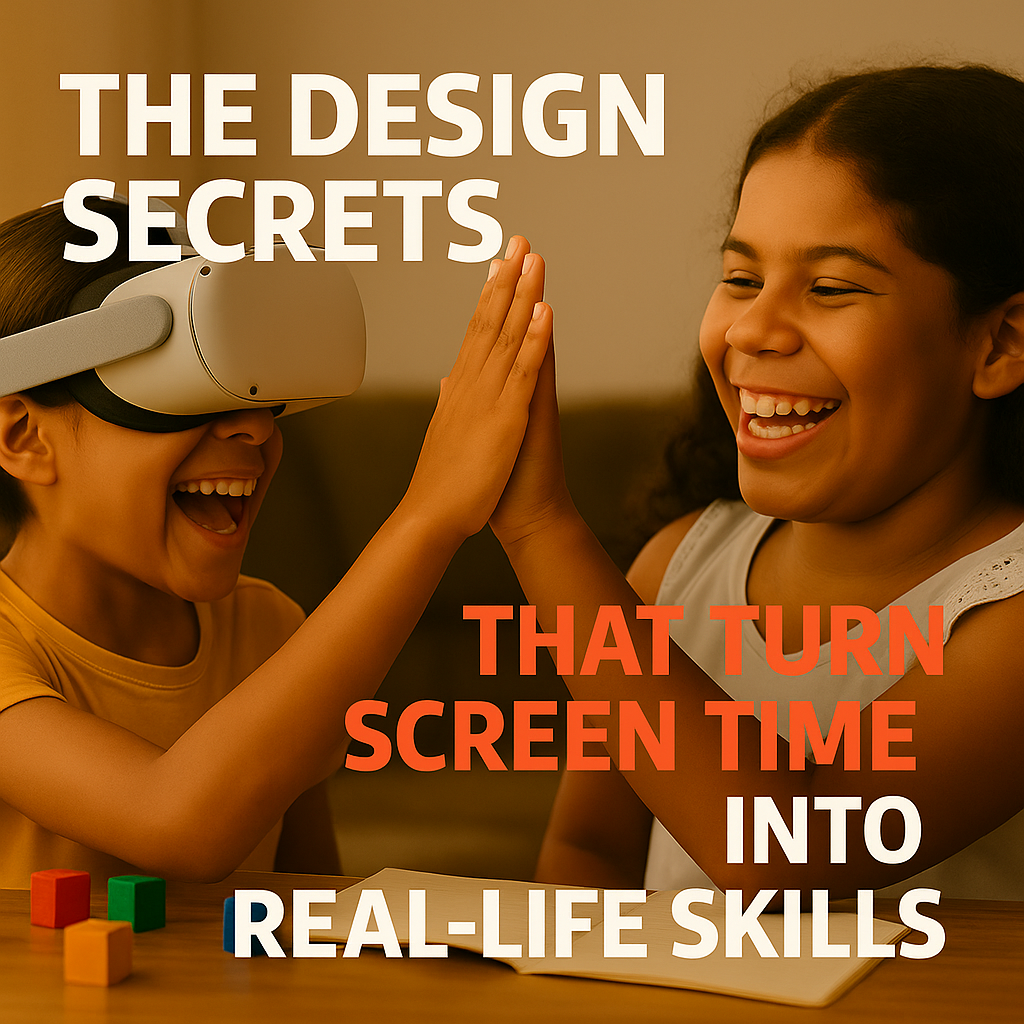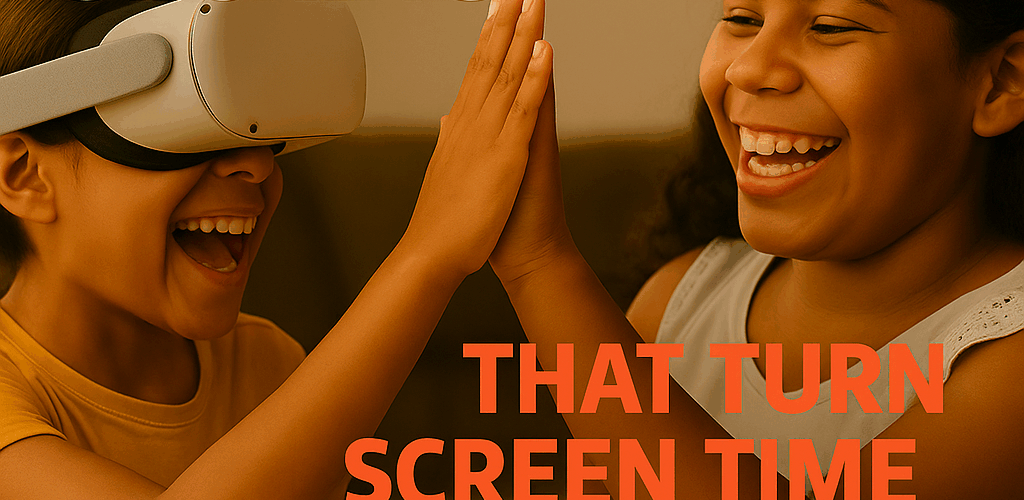
Not all screen time is equal. Some drains kids, some distracts them— but a rare kind actually build real-life skills they’ll use for life. The difference isn’t just what kids watch or play, it’s how those experiences are designed.
In Part 1 of this series, we explored the future of SEL and VR and why learning life skills will define the next chapter of education. In Part 2, we heard directly from families about the tug-of-war between distraction and growth at home.
Now comes the most important question: how do we actually make screen time matter?
The answer lies in three design secrets of play: story, loops, and interaction. These are the mechanics that transform screen time into real-life skills.
For the past decade, we at Red Iron Labs have been building games that help people learn and connect. And in that time, we’ve discovered something important: every great game shares these same three building blocks. They are the mechanics of fun, and when applied to SEL, they also become the mechanics of growth.
Why Game Design Matters for Building Real-Life Skills
Parents already know the truth: kids learn best through play. But not all play is created equal.
- A Bluey episode can spark empathy, but kids remain observers.
- Minecraft encourages creativity, but lessons often stop at fun.
- YouTube keeps kids hooked, but rarely builds lasting skills.
So what makes the difference between screen time that drains kids and screen time that helps them grow? The answer is game design.
The Three Building Blocks of Play for Real-Life Skills
Story gives meaning
Stories are how kids make sense of the world. Whether it’s Bluey figuring out fairness in Shadowlands or a player stepping into a new VR adventure, narrative creates emotional connection. SEL thrives in story because emotions have context— kids don’t just hear about empathy, they feel it alongside characters.
But story alone is not enough. For kids to practice real-life skills, the story has to move from passive watching into active doing.
Loops create practice
In games, loops are the repeating cycles of play: try, fail, adjust, succeed. They’re why kids build endlessly in Minecraft or keep retrying a tricky Mario Kart track. Loops turn challenge into growth by offering safe spaces to practice resilience.
This is exactly what SEL needs. Kids don’t learn perseverance by being told to “try again”— they learn it by experiencing the cycle of frustration, retrying, and overcoming. Loops are where resilience becomes a lived real-life skill.
Interaction makes skills stick
The final ingredient is interaction—the choices kids make and the feedback they receive. Unlike watching a show, games put children in the driver’s seat. They cooperate, negotiate, and test boundaries with others.
Interaction transforms SEL from a lesson into lived experience. Empathy isn’t just defined, it’s practiced when a teammate feels left out. Confidence isn’t abstract, it’s felt when a child takes a risk and sees they can succeed.
Why VR Takes Real-Life Skills Further
VR amplifies these building blocks. Instead of watching characters on a screen, kids step into the story. Instead of hearing about resilience, they laugh, fail, and try again with their whole body.
For teachers, most VR tools today focus on STEM or single-player exercises. For parents, most digital options lean either toward passive shows or pure entertainment. Very few tools combine story, loops, and interaction with intentional SEL outcomes.
That’s the rare space Muffin Fight 2 is designed to fill:
- Story frames the challenge (e.g., a tug-of-war against the wind).
- Loops provide resilience practice (fail, laugh, and try again).
- Interaction makes it real (teammates negotiate, celebrate, and problem-solve together).
VR Doesn’t Replace—It Augments
Since the day we started building VR games, we’ve heard the same expectation, born out of sci-fi: that virtual reality would replace reality. After more than 10 years of creating innovative VR solutions, I can tell you no one is really doing this.
The value of VR isn’t about escape, it’s about augmentation. It gives kids new ways to practice the same lessons that still matter in classrooms, playgrounds, and homes. SEL taught by a teacher is still vital. Worksheets and role-play still have their place. VR doesn’t replace them— it expands them.
And for a generation of digital natives growing up inside technology, we need to design solutions in the spaces they already understand. Game-designed VR SEL experiences aren’t the only way, but they’re a powerful way because they meet kids where they’re at.
Parents and Teachers Both See the Gap
In interviews, parents told us transitions are the hardest part. They need games with natural stop points—episodic loops that make it easier to say “one more round” instead of “five more hours.”
Teachers told us most SEL tools stop at naming emotions but don’t teach coping. They want resources where kids can actually practice communication and resilience.
Game design answers both: structured loops give parents manageable sessions, and interactive play gives teachers real SEL skill-building.
What Ten Years of VR Taught Us About Play
When we first started building VR, much of our work was simulation-based: compliance training, safety drills, HR onboarding. They were effective because they reduced risk, but they weren’t playful. As Lloyd (the other founder) often says, “If people can’t get through the experience because the controls are too complex, then we’ve failed.”
Over time, we learned that what makes VR transformative isn’t just its realism— it’s the play. When you weave in story, loops, and interaction, the technology stops being about replacing training and starts being about augmenting growth. That shift—from simulations to playful, skill-building experiences is what brought us to Muffin Fight today.
The Future of SEL in VR (and at Home)
The future of SEL in VR won’t come from more lectures, nor from endless entertainment. It will come from designing playful, connected spaces where story, loops, and interaction work together.
But here’s the key: it doesn’t start in a headset. It starts at home. Parents who weave these building blocks into daily play are already preparing kids for the future— no headset required!
Extending the Lessons Beyond VR
That’s why we’ve taken the same design secrets we use in VR and applied them in a new activity booklet. Inside are simple, playful exercises built on story, loops, and interaction— so families can practice resilience, empathy, and confidence together at the kitchen table.
This wasn’t a side project. It’s proof that the mechanics that make VR transformative can be applied anywhere kids play. Whether in immersive worlds or in everyday family life, story, loops, and interaction are the bridge between fun and real-life skills.
Follow Us
These design secrets explain why kids get hooked on games— and how we can use the same mechanics to help them grow. VR shows us the frontier, but families can begin today. If you’re interested in learning more, follow us on LinkedIn or Instagram.
We’re currently working on a webinar The Hidden Power of Play: Why Fun Builds Real-Life Skills. We’ll show how story, loops, and interaction work in practice, and you’ll leave with practical strategies you can use right away to turn screen time into growth— and a free mini play pack to make it fun at home.
Because when screen time stops being a battle and starts being a chance to practice resilience, empathy, and confidence, that’s when play becomes powerful.

